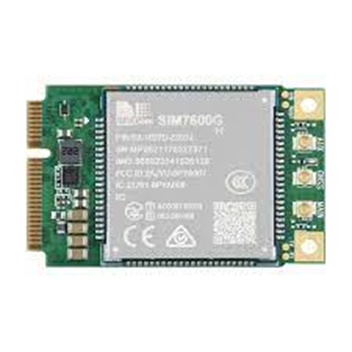2.Environmental Monitoring at Mt.Chalmers Mining Site Part 2: GSM Connectivity Enhancement ...

Introduction Welcome to the second part of our case study on Environmental Monitoring at Mt. Chalmers Mining Site. Here, we delve into GSM Connectivity Enhancement, focusing on its application with the MC-1N device. Robust connectivity is pivotal for real-time data transmission in environmental monitoring. This study explores the significance, implementation, and impact of GSM Connectivity Enhancement in ensuring efficient operations at the mining site. Here you can check the first part of this Case Study - https://www.inthings.tech/case-studies-details?pid=107
Problem Statement In this case study, we have used the device MC-1N, which uses the PCB2V5 board with the GSM modem. The device collects and sends out important data to the IOTHub. These include various parameters like temperature, humidity, wind speed and other data related to the various sensors to monitor the environment. Therefore, internet connectivity is a crucial component to monitor data seamlessly. While using the GSM modem, there were a lot of cases where the device lost connectivity even though the RSSI value specified in the logs were in an acceptable range. To mitigate this issue, we can use additional diagnostic parameters.
Diagnostic Parameters
There are four types of Diagnostic Parameters:
1.RSS (Received Signal Indicator)
It's a measurement of the power level of a radio signal received by an antenna. It's essentially how strong a signal is when it reaches your device, like a smartphone or laptop. RSSI is primarily used in wireless technologies like:- Wi-Fi : Helps assess the strength of your Wi-Fi connection.
- Cellular networks: Used to gauge the quality of your mobile network connection.
- Bluetooth : Helps troubleshoot Bluetooth connectivity issues.
- Radio frequency identification (RFID): Used to ensure proper communication between RFID tags and readers.
RSSI is measured in decibel-milliwatts (dBm). A higher dBm value indicates a stronger signal, while a lower value indicates a weaker signal. Generally, a higher RSSI is better, as it provides a stronger and more reliable connection.
Typical RSSI values for an LTE network:
• Excellent: -30 to -50 dBm• Good: -50 to -70 dBm
• Fair: -70 to -90 dBm
• Poor: -90 to -110 dBm
•Unusable: Below -110 dBm
For an optimal LTE connection, the ideal RSSI value would be between -50 dBm and -70 dBm. This range signifies a strong signal with excellent data speeds and reliable connectivity.
RSSI values are dependent on several factors such as:
• Band: Different LTE bands can have slightly different signal characteristics. • Cell tower distance: Signal strength naturally weakens with distance from the cell tower. • Environment: Buildings, trees, and other obstacles can weaken the signal. • Device: Different devices have different antenna capabilities and sensitivities.Therefore, while values between -50 dBm and -70 dBm are generally considered optimal, a value above -85 dBm should still provide a satisfactory LTE connection.
Importance of RSSI:
Understanding RSSI help diagnose and troubleshoot various wireless connectivity issues, such as:
• Slow connection speed: A weak RSSI can lead to slower data transfer speeds.
• Dropped connections: Frequent disconnections might indicate a weak signal strength.
• Interference: Nearby electronic devices can interfere with wireless signals and weaken the RSSI.
2.SNR (Signal-to-Noise-Ratio)
It's a measure used in science and engineering that compares the strength of the desired signal to the strength of the background noise. In simpler terms, it tells you how clear and distinct a signal is compared to the unwanted signals around it. SNR is usually expressed as a ratio (e.g., 10:1) or in decibels (dB). A higher ratio or dB value indicates a stronger signal relative to the noise, which is generally better.Typical SNR values for an LTE network: • Excellent: Above 15 dB
• Good: 10 dB to 15 dB
• Fair: 5 dB to 10 dB
• Poor: Below 5 dB
Importance of SNR:
A high SNR is crucial for various applications, including:
• Communication: Enables reliable transmission of information (e.g., voice calls, data transfer).
• Imaging: Produces clear and detailed images (e.g., medical imaging, photography).
• Sensors: Enables accurate detection of signals (e.g., temperature sensors, microphones). Factors affecting SNR: Several factors can affect SNR, such as:
• Signal strength: Weaker signals have a lower SNR.
• Distance: The signal strength weakens with distance from the source, leading to lower SNR. \
• Noise level: Higher noise levels (e.g., interference) lower the SNR. • Device sensitivity: Devices with better sensitivity can achieve higher SNR.
3. RSRP (Reference Signal Received Power)
It's a key metric used in 4G LTE networks to measure the strength of the received signal. Unlike RSSI, which provides a general indication of signal strength, RSRP specifically focuses on the power of the reference signals sent by the cell tower. These signals are used by your device to synchronize with the network and establish a connection. RSRP is measured in decibel-milliwatts (dBm). Higher dBm values indicate a stronger signal, while lower values indicate a weaker signal.
Typical RSRP values of an LTE network:
• Excellent: Above -90 dBm
• Good: -90 dBm to -100 dBm
• Fair: -100 dBm to -110 dBm
• Poor: Below -110 dBm
Importance of RSRP: A strong RSRP is crucial for several reasons:
• Improved data transfer: A strong signal allows for faster data transfer speeds and more reliable connections. • Enhanced battery life: Your device doesn't have to work as hard to maintain a strong signal, leading to better battery life.
Factors affecting RSRP: Several factors can affect RSRP, including:
• Distance from the cell tower: The signal weakens with distance, leading to lower RSRP.
• Obstacles: Buildings, trees, and other obstacles can block the signal and weaken RSRP.
• Weather conditions: Rain, snow, and other weather conditions can also impact signal strength.
• Network congestion: When many users are connected to the same cell tower, it can lead to a weaker signal and lower RSRP for everyone.
4. RSRQ (Reference Signal Received Quality)
RSRQ is the another important metric used in 4G LTE networks to assess the signal quality. While RSRP measures the strength of the received signal, RSRQ goes a step further and considers the noise level and interference present. In simpler terms, RSRQ tells you how clear and usable the signal is, not just how strong. RSRQ is calculated as a ratio:RSRQ = (N * RSRP) / RSSI
• N: Number of resource blocks used in the measurement.
• RSRP: Reference Signal Received Power (described earlier).
• RSSI: Received Signal Strength Indicator (described earlier).
RSRQ is a unitless value, typically ranging from 0 to 34. Higher values indicate better signal quality, while lower values indicate worse quality.
Typical RSRQ values:
• Excellent: Above -3 dB
• Good: -3 dB to -5 dB
• Fair: -5 dB to -7 dB
• Poor: Below -7 dB Importance of RSRQ of an LTE network: RSRQ is crucial for:
• Reliable data transfer: A good RSRQ ensures fewer errors and interruptions, leading to smoother data transfer.
• Enhanced battery life: Like RSRP, a good RSRQ reduces the strain on the device, improving battery life. Factors affecting RSRQ: Like RSRP, factors impacting RSRQ include:
• Distance from the cell tower: Signal weakens with distance, leading to lower RSRQ.
• Obstacles: Buildings, trees, and other obstacles can block the signal and worsen RSRQ.
• Network congestion: When many users are connected, it can increase noise and lower RSRQ for everyone.
• Interference: Other electronic devices can emit signals that interfere with the LTE signal, reducing RSRQ.
Analyzing with received Values
We have looked at MC-1N device, here.
● RSSI varies from -60 dB to -70 dB, which indicates good signal quality.
● SNR varies from 8 dB to 15 dB, which indicates a fair amount of noise.
● RSRP varies from -95 dBm to -105 dBm, which indicates the low power of the received signal.
● RSRQ varies from -8 dB to -12 dB, which indicates the poor quality of the received signal.
Conclusion
In conclusion, enhancing GSM connectivity at Mt. Chalmers Mining Site entails a multifaceted approach aimed at optimizing signal strength and minimizing noise interference. Our recommendations for improvement encompass strategic actions:
• Signal Amplification: This increases the signal strength relative to the noise.
• Noise Reduction: This can be achieved through filtering, shielding, or choosing a quieter environment.
• Utilization of Enhanced Antennas: Investing in improved antennas amplifies signal strength and improves RSRP, especially in areas with weak coverage.
• Exploration of Alternative Connectivity Methods: Using alternative methods like LoRa, we can have a more stable received signal.
